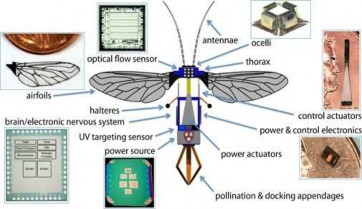RoboBee: An insect Drone
♤ RoboBee is a tiny robot capable of tethered flight, developed by a research robotics team at Harvard University.
♤ Inspired by the biology of a bee, scientists developed a tiny winged craft that could be used as a surveillance drone.
♤ Flying insects are small enough to get into any tight space and go unnoticed and this was the vision of these Nature-inspired researchers.

♤ The project envision that the Nature-inspired research could lead to a greater understanding of how to artificially mimic the collective behavior and “intelligence” of a bee colony; foster novel methods for designing and building an electronic surrogate nervous system able to deftly sense and adapt to changing environments; and advance work on the construction of small-scale flying mechanical devices.
♤ The devices will open up a wide range of discoveries and practical innovations, advancing fields ranging from entomology (the branch of Zoology concerned with the study of insects) and developmental biology to amorphous computing and electrical engineering.
♤ RoboBee's wingspan is 3 centimetres, which is believed to be the smallest man-made wingspan to achieve flight. The wings can flap 120 times per second and be controlled remotely in real time. Each RoboBee weighs 80 milligrams.
♤ Practical applications:
o It can help in artificial pollination of a field of crops.
o A group of RoboBees with their swarm intelligence can be very useful in search and rescue operations e.g., in the aftermath of a natural disaster.
o Hazardous environment exploration can be done using RoboBee.
o It can also help in Military surveillance.
o High resolution weather and climate mapping can be done by these artificial Bees.

o It can help in Traffic monitoring.

